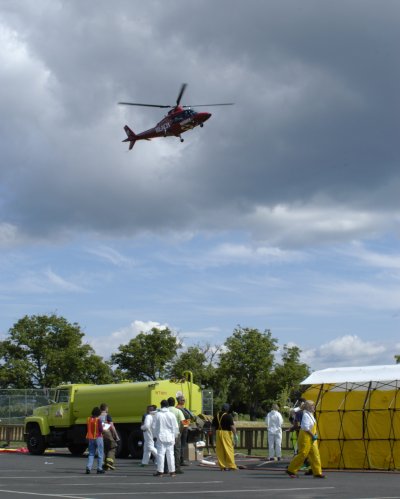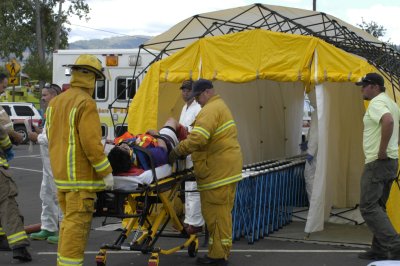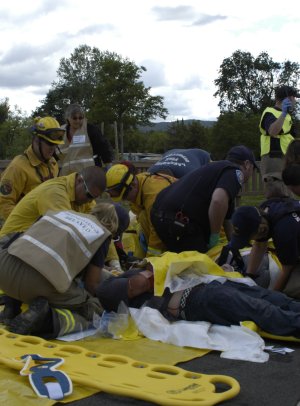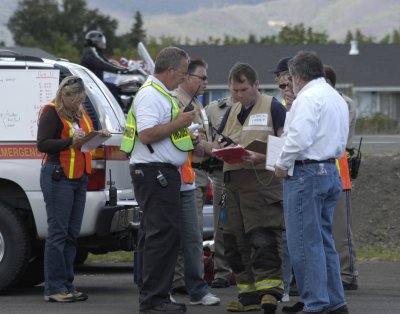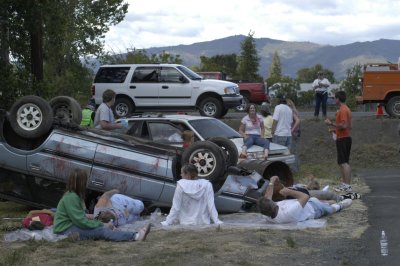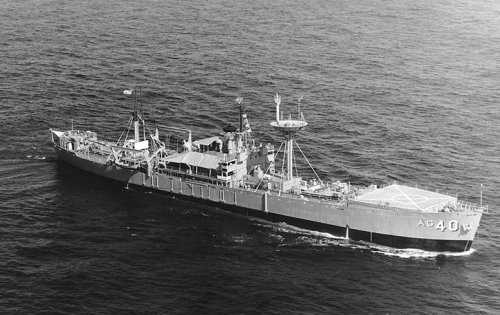
NORTH COAST, Calif. – Years after he left the military, Jack Alderson began asking questions about chemical testing he was involved in and its effects on his health and the health of others.
Those efforts led to the introduction of a bill earlier this month that would offer health benefits to veterans exposed to chemical agents during two classified government projects in the 1960s and 1970s.
North Coast Congressman Mike Thompson (D-St. Helena) and Republican Congressman Denny Rehberg of Montana introduced HR 5954 on May 1.
If passed, the bill will provide Veterans Affairs health benefits to veterans who were exposed to biological, chemical or other toxic agents as part of Project 112 and Project SHAD.
Rehberg said the legislation is loosely crafted after that which was written to address Agent Orange. A similar bill previously was introduced but it died in the Senate.
Project 112, which included Project SHAD, was a series of tests conducted between 1963 and 1973 by the Department of Defense and other federal agencies, according to Thompson and Rehberg. During these projects, a number of weapons containing chemical and biological agents such as VX nerve gas, Sarin nerve gas and E. coli were tested on unknowing military personnel.
According to the Force Health Protection and Readiness Program tests were conducted on the open sea in the North Atlantic, open water locations of the Pacific Ocean and near the Marshall Islands, Hawaii, Baker Island, Puerto Rico and the California coast. In addition, there were land-based tests in Alaska, Hawaii, Maryland, Florida, Utah, Georgia and in Panama, Canada and the United Kingdom.
Testing took place at the Deseret Test Center at Fort Douglas, Utah, according to a Department of Defense fact sheet. Project SHAD – which stands for “Shipboard Hazard and Defense” – took place offshore.
Its purpose was “to identify U.S. warships' vulnerabilities to attacks with chemical or biological warfare agents and to develop procedures to respond to such attacks while maintaining a war-fighting capability,” the Department of Defense fact sheet explained. The project sought to find out how chemical and biological agents behaved under different climatic, environmental and use conditions.
But the true nature of the classified projects was kept under wraps for decades, and is still only slowly being revealed, according to Thompson.
Bringing the truth to light
Shortly after he was elected to Congress in 1998, Thompson said he was approached by one of his constituents from Humboldt County, Ferndale resident Jack Alderson, who had been a tugboat commander during Project SHAD. Alderson had become ill and had cancer issues but couldn't get answers about the project from the government.
“For years they denied that this was ever happening,” said Thompson.
Similarly, Rehberg said he was approached by a constituent on the day he was sworn into Congress in 2001.
Alderson, 74, said he's been fighting to break the issue loose since 1993.
When President John F. Kennedy was elected, the US had a strong nuclear program, but lacked similar strength in biological and chemical weaponry, explained Alderson.
Kennedy directed his secretary of defense, Robert McNamara, to strengthen the nation's chemical program, and the result was Project 112 which included Project SHAD and gave rise to the development of chemical weapons such as Agent Orange, said Alderson.
In October of 1964, Alderson – at the time a 32-year-old lieutenant who had served in the Navy for 10 years – was assigned to Project SHAD, along with several hundred other experienced sailors and officers. The point was to see how a Navy warship could hold up under chemical attack.
“We were all ordered in,” Alderson said. “None of us were volunteers.”
The testing involved all branches of the military. Alderson commanded five Army tugboats, each of which had a Navy lieutenant as the officer in charge and a crew of 11 sailors, handpicked for their experience and secret clearances.
Alderson said they were trained how to decontaminate a ship after a test and conduct air sampling. After two months of training, he reported to his superiors that they were ready for their mission.
President Lyndon Johnson signed off on the tests, which Alderson said commenced in January of 1965.
The tugboats left Pearl Harbor, Hawaii, and went to Johnston Island, southwest of the Hawaiian islands, where Alderson said the tests took place. Accompanying the tugs was the laboratory ship, Granville S. Hall.
Alderson said the tugs would go out to sea for six days at a time, and would form a line as long as 100 miles. On their decks would be three caged Rhesus monkeys, although some tests didn't involve animals.
Two Marine jets would fly over and spray a chemical weapon – including E coli., Bacillus globigii, Coxiella burnetti, Pasteurella tularensis and fluorescent particles – as well as a trace element and simulants. Alderson said the tugs had small labs on board, where they would take air samples. All of the chemicals used were carcinogenic.
Some tests involved the tugs taking out barges of monkeys which were sprayed with the neurological agents Sarin and VX. Those agents weren't used directly on the tugs, said Alderson.
The tugs would then go to the laboratory ship in rotations, taking the sick monkeys and their air samples. “The monkeys were not in good shape,” he said.
The monkeys, if they survived, would be observed by lab technicians on the laboratory, who eventually would euthanize the animals and conduct necropsies on them.
Alderson and his fellow Navy men began to suffer health problems themselves, including respiratory issues. They also noticed their immune systems suffered after they were vaccinated against the chemical agents.
The operations in the Pacific were carried out through rehearsal and written instructions, said Alderson. They stayed off the radio, not wanting anyone to know they were there conducting tests.
Alderson was involved in the secret operations until 1967. He made trips back to the Deseret Testing Center in Ft. Douglas, Utah, and that's where he met Jack Barry, who had been in an Army chemical corps for five years but was a civilian working for the Department of Defense by the time he met Alderson.
Barry, who was the right-hand man to the Marine colonel overseeing a number of biological tests, would be in Oahu, Hawaii, during the late spring and early summer of 1965, when officials carried out “Big Tom,” a Navy test that focused on the vulnerability of island naval bases in the event of a biological or chemical attack from the sea.
The drift of that test – which used Zinc Cadmium Sulfide and liquid Bacillus globigii – came in from sea and went across parts of the island, said Barry.
Barry said that similar drift tests, using the same chemicals as well as nerve agents, were conducted near Fort Greeley, Alaska. A fact sheet on Project SHAD's “Shady Grove” operations said tests took place at Eglin Air Force Base in Florida.
Alderson said he doesn't think the Department of Defense wants it known just how many tests were done near civilians and on or near US soil.
When Alderson and Barry left their involvement with the tests, they said they were threatened with prosecution and prison time in Ft. Leavenworth if they disclosed anything about the operations.
Discovering troubling common threads
Alderson later went on to become chief executive officer of the Humboldt Bay Harbor District from 1975 to 1996. Barry left the Desert Testing Center in 1975 and joined the US Forest Service, moving to Davis to manage a technology development enterprise team.
In 1993, Alderson said he and some of the men who he served with decided to get together for a reunion.
It was a challenge, he said, to gather the men, who largely hadn't kept in touch. Most of the men wouldn't speak to their former Navy colleagues on the phone or answer anything in writing.
He said they did finally manage to get together for a small reunion in San Diego, where about 40 people came.
When they got together, they discovered many of them had suffered ongoing respiratory problems and various types of cancer. Alderson himself has had malignant melanoma, the most severe form of skin cancer. He also discovered that he has four pieces of asbestos in his lungs. In addition, he has had prostate cancer, and suffers from fatigue syndrome and severe allergies, the latter of which he said developed immediately after he was inoculated during the Project SHAD years.
When he discovered that he wasn't alone in his health concerns, he decided to start looking for answers.
The first politician he approached was US Sen. Dianne Feinstein, who had visited the harbor district to discuss a harbor dredging project. While she was in Alderson's office, he shared his story.
Feinstein asked him to write her a letter outlining the situation, which she in turn took to the Department of Defense, which responded that Alderson should contact them directly. That, he said, was their way of putting him off.
It wasn't just the government pushing back on Alderson's requests. He said he went to a veterans group with his story. Their response, he said, was that the government wouldn't do that to its servicemen.
Meanwhile, Thompson had gotten into Congress, and the two men knew each other from having worked together on local issues when Thompson was in the state Senate. Alderson took him the story and began working with Thompson and his staff, who Alderson credits with doing a lot of hard work and investigation to bring the issues to light.
The Department of Defense at first denied that the program had taken place. But in May 2000 Alderson said CBS began doing TV reports on the issue.
Following pressure by Thompson and further investigation by CBS, the Department of Defense released a fact sheet on Project SHAD, a copy of which was obtained by Lake County News.
The date of the release? Sept. 13, 2001.
“You saw it in the paper, didn't ya?” Alderson joked.
He said he believes the government's timing was calculated for release during a time of crisis so that the issue wouldn't draw attention.
While getting classified information on the testing hasn't been possible, Alderson said a lawsuit regarding Project SHAD resulted in the deposition in 2004 of the project's plans and operations officer and lead scientist, Dr. J. Clifton Spendlove.
While the Department of Defense had claimed that most of the records for Project SHAD were destroyed or had deteriorated, Spendlove said most of the records were still in Utah, and he additionally stated he had filmed some of the tests.
“We have enough evidence that we believe Dr. Spendlove was telling the truth,” said Alderson.
Spendlove also has testified publicly about the project before a special advisory panel convened by the Institute of Health.
Gradually, however, the issue began making its way into news reports, which is where Barry saw it.
He said he wrote to Thompson to tell him of the civilians who were exposed. Alderson found out about Barry's letter and the two men reconnected. At Alderson's invitation, Barry has since joined a special subcommittee set up by the Vietnam Veterans of America to work on issues related to Project SHAD.
Barry himself currently suffers from a rare form of cancer, but he says he's unsure if it's from the testing, his previous Army service or even time in the Forest Service, which also used toxic chemicals.
Thompson said that while the government eventually admitted the reports were correct, “We haven't had the level of cooperation from our government that we believe we should be getting.”
Finding the people exposed has been even more of a challenge, said Thompson.
Rehberg said preliminary estimates are that as many as 6,000 vets were exposed to the toxic agents, along with as many as 1,500 civilians. Thompson said Vietnam Veterans of America believes the numbers of vets exposed are actually much higher.
Alderson said that, just counting technical staff involved in the testing, between 500 and 600 people were affected. If you add in the many others on Navy ships exposed to the chemicals, the number climbs to 6,000. Add in “white coats” – people who were conscientious objectors and wouldn't fight but who volunteered for chemical tests – and that brings the number up to 18,000.
About 50 to 60 percent of the men he worked with on the light tugs are now dead, Alderson said, including six of the operation's 10 officers.
“We have some vets that are long dead because of the exposure they received, and that's just wrong,” Thompson said.
Government won't make effort to reach affected vets
The two congressmen faulted the government for a shoddy attempt to notify those who were exposed once they were identified.
Rehberg said he found it appalling that the government did the tests, then shirked its responsibility to help veterans.
In February, a US Government Accountability Office report stated that the Department of Defense and the Veterans Affairs needed to improve efforts to identify and notify individuals exposed to chemical and biological tests.
The report added that tens of thousands of military personnel and civilians have been exposed to such tests by the Department of Defense.
“Since 2003, DOD (Department of Defense) has stopped actively searching for individuals who were potentially exposed to chemical or biological substances during Project 112 tests, but did not provide a sound and documented basis for that decision,” the report stated. “In 2003, DOD reported it had identified 5,842 service members and estimated 350 civilians as having been potentially exposed during Project 112, and indicated that DOD would cease actively searching for additional individuals.”
The following year, the Department of Defense ruled that the recommendation to continue an active search for those exposed “had reached the point of diminishing returns, and reaffirmed its decision to cease active searches,” a decision that the Government Accountability Office said “was not supported by an objective analysis of the potential costs and benefits of continuing the effort.”
From 2003 on, other organizations, such as the Institute of Medicine, identified an additional 600 people who could have been exposed. “Until DOD provides a more objective analysis of the costs and benefits of actively searching for Project 112 participants, DOD’s efforts may continue to be questioned,” the report stated.
The Lake County Veterans Service Office confirmed to Lake County News that they have received inquiries about Project SHAD from local veterans who think they may have been affected.
For the vets involved, it's tough for them to get treatment once they confirm their involvement in the tests, because the Veterans Administration has refused to provide them with health benefits or compensation for their diseases, which is a reason for the bill, said Thompson.
Alderson said he and others involved in the testing have had problems with their medical records, portions of which have been known to disappear.
The bill instructs the Secretary of Veterans Affairs within 180 days of enactment to notify all veterans of potential exposure to the biological or chemical weapons used in Project 112 and Project SHAD.
HR 5954 would “establish a presumption of service connection,” said Thompson, which would mean that once a vet was identified, any health issues would be presumed service-related.
“It's our hope that once this happens we can get them that health care they need,” Thompson said. “They should not be denied and neglected any more”
Although the bill's previous version died in the Senate, Thompson and Rehberg said they have assurances from Congressman Bob Filner, chair of the House Committee on Veterans Affairs, that he'll get a hearing for the bill quickly.
“I'm feeling cautiously optimistic that we'll be able to have some success this time,” Thompson said.
Vietnam Veterans of America has endorsed the legislation, the congressman noted.
Rehberg credited Thompson for taking the lead on the matter. “When Mike gets his teeth in your ankles, he's not going to let go.”
Thompson said the government's denial and refusal to take care of the affected veterans has gone on far too long – more than 40 years in some cases.
Alderson, who previously has testified on Project SHAD before the Senate Armed Services Committee – said Thompson has asked him to come and testify before Congress during the bill's first hearing, scheduled for June 12, before the House Committee on Veterans' Affairs Subcommittee on Disability Assistance and Memorial Affairs.
Barry credited Alderson for working to bring the project to light. “He's not in it for personal gain. He's looking after his people.”
E-mail Elizabeth Larson at This email address is being protected from spambots. You need JavaScript enabled to view it..

 How to resolve AdBlock issue?
How to resolve AdBlock issue? 